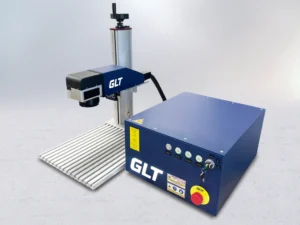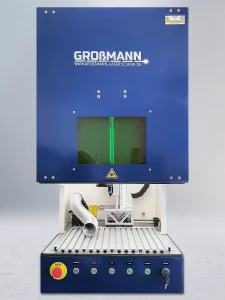
Here we provide you with detailed information to help you make the right choice.
Topic overview
The fiber laser as a marking laser for metals and plastics
The fiber laser is a high-precision tool for a variety of applications. Here are some of its advantages and disadvantages:
Advantages
- High precision: Fiber lasers offer exceptional resolution and accuracy, making them ideal for fine marking and detailed laser engraving.
- Fast marking speed: Fiber lasers generally work very quickly, which leads to efficient production and short processing times.
- All-rounder: Fiber lasers can process various materials such as metals, plastics, ceramics and more, making them suitable for a wide range of applications.
- Low maintenance: Fiber lasers require less maintenance than other laser types and have an extremely long service life of up to 80,000 hours.
Disadvantages
- Limited variety of materials: Fiber lasers are not suitable for all materials. For example, they cannot process glass or organic materials well or only in a coated form.
Materials to be processed with the fiber laser:
- Metals
Fiber lasers are particularly suitable for laser marking and laser engraving of metals such as stainless steel, aluminum, copper, brass and titanium. - Plastics
Many types of plastic can be processed with a fiber laser, including ABS, PVC, PET, PMMA (acrylic dyed), nylon, polypropylene and many more. - Coated materials
Fiber lasers can also create laser markings and laser engravings on coated materials such as anodized aluminum, painted surfaces and coated steel, as well as decoating surfaces. - Ceramics
Some types of ceramic materials can be processed with a fiber laser, especially if they have a special coating that is optimized for laser marking. - Glass
Although fiber lasers are not ideal for engraving glass, they can create markings on special glass surfaces, especially if they have an appropriate coating.
It is important to note that the exact suitability of a fiber laser for a specific material depends on various factors, such as material composition, thickness, surface finish and desired results. It is advisable to carry out test runs before processing a specific material to determine the best parameters and settings for optimal results.
The UV marking laser for plastics and organic materials
The UV laser is particularly suitable for certain applications and is very versatile compared to other laser systems.
An ultraviolet laser (UV) combines some positive properties between CO2 and fiber lasers and is therefore a general "all-rounder".
Advantages
- Precise and extremely fine markings
UV lasers offer high resolution and are ideal for applications that require very fine marking, such as in the electronics industry. The "cold" processing allows contours to be displayed even more sharply. - Good material compatibility
UV marking lasers are well suited for sensitive materials such as glass, plastics and medical devices due to the so-called "cold" processing. - Oragnian fabrics
Similar to a CO2 laser, a UV laser can also laser mark or laser engrave wood or leather, for example. - Decoating of metals
Similar to the fiber laser, a UV marking laser can also be used to remove coatings from metals. - Engraving & tempering of metals
If a UV laser with sufficient wattage is selected, it is able to engrave metals or produce annealing markings. However, the process time is many times longer compared to a fiber laser.
Disadvantages
- Limited processing speed
UV lasers generally work more slowly than other laser types, which leads to longer processing times. - Smaller machining area
Due to the lower power of UV laser systems compared to other systems, the working areas are usually significantly smaller. - Higher acquisition costs
The acquisition costs for UV lasers are higher than for fiber lasers or CO2 lasers. - Reduced service life
The service life of UV marking lasers is often only 1/3 of that of a fiber laser.
You can find a detailed comparison of the service life here.
Materials
- Glass
UV lasers can laser mark and laser engrave glass materials such as flat glass, hollow glass, glass tubes and glass bottles. - Plastics
Various plastics such as acrylic (PMMA), ABS, PVC, PET, polypropylene and many others can be laser-marked with a UV laser. - Coated materials
UV lasers can create laser markings and laser engravings on coated surfaces, including metal coatings. - Ceramics
Some ceramic materials can be processed with a UV laser, especially if they have a suitable coating. - Medical devices
UV lasers are often used in medical technology to apply markings to medical instruments, implants and medical plastic devices.
It is important to note that the exact suitability of a UV laser for a particular material depends on various factors, such as the material composition, surface finish and desired results. Here too, it is advisable to carry out test runs before processing a specific material in order to determine the best parameters and settings for optimum results.
The CO2 marking laser
The CO2 laser is known for its wide range of applications and is often an inexpensive entry-level system.
Here are its advantages and disadvantages:
Advantages
- High performance
Similar to fiber lasers, CO2 lasers are available with very powerful laser sources and are ideal for applications that require deep laser engraving or cutting processes on organic materials, glass or acrylic. - Variety of materials
CO2 lasers can process a variety of materials such as wood, paper, plastics, acrylic and leather. - Lower acquisition costs
CO2 systems are generally cheaper than UV or fiber lasers, depending on the desired configuration.
Disadvantages
- Lower precision
Compared to fiber and UV lasers, CO2 lasers offer a lower resolution. - Larger dimensions
CO2 lasers are generally larger and require more space than other laser types. - Engravings on glass, for example, are not as rich in contrast as with a UV system.
Materials
- Wood
CO2 lasers can laser mark and laser engrave wood materials such as plywood, MDF, beech, pine, oak and other woods. - Paper and cardboard
CO2 lasers are well suited for processing paper and cardboard materials, for example for the production of packaging, greeting cards or cutting templates. - Textiles
Textiles such as cotton, linen, felt and synthetic fabrics can be marked or cut with a CO2 laser, for example for the textile industry or the production of textiles with personalized designs. - Plastics
CO2 lasers can process various plastics such as acrylic, PVC, ABS, polycarbonate and others. They can be used in the advertising industry, for example, for the production of signs, displays or lettering. - Stone and ceramics
CO2 laser marking lasers can engrave certain stone and ceramic materials, especially if they have a special coating for laser processing.
It is important to note that the exact suitability of a CO2 laser for a specific material depends on various factors, such as material thickness, density, surface finish and the desired results. Before processing a specific material, test runs should be carried out to determine the best parameters and settings for optimal results.
INTEGRA marking laser
Cost-effective stand-alone marking laser

Marking laser GRAVIS
The safe ALL-IN-ONE marking laser for companies

If the laser system INTEGRA do not meet your expectations, we would like to introduce you to another laser marker:
The GRAVIS laser marker as a complete solution.
Thanks to the modern MOPA technology can be used with the Gravis produce precise, high-contrast or even colored laser markings and laser engravings on many materials.
Optionally available in Laser protection class 1 or 2, this laser engraving machine offers a safe solution for many applications.
Thanks to the optional X-axis, large marking fields can be realized even with small optics, ideal for series production.
